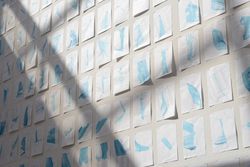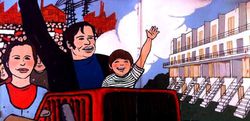Projet
BMI/HQ
AP144.S2.D74
Description:
File documents the unexecuted design for the headquarters of the Birmingham and Midland Institute (BMI), in Birmingham, England. This project is related to the Shantasea Development (AP144.S2.D72) from which Cedric Price resigned as architect to take on the role of architect for BMI, one of the proposed tenants for the Shantasea project. Cedric Price proposed a municipal and regional "nerve centre" to house seminar and study rooms, workshops, galleries, film, television and music studios, a library, a planetarium, and a theatre. A flexible life-cycle plan (expansion, static, contraction) for the building and the activities would allow BMI to expand in the short and medium term, and to shrink in the long term, when it was assumed that many of its roles would be replaced by the UK's Open University plan (Works II, 42). Work on the project came to a stop in 1970 under a new city council (Architectural Design, June 1971, 368). Existing conditions material consists of maps and a survey of Birmingham. Conceptual sketches and drawings include: annotated diagrammatic plans and sections used to develop the building's massing and the horizontal/vertical relationships between functional areas; axonometric views showing the building's general form/functions; plans used for calculating square footage; diagrams showing visual and physical movement through the building; information and movement charts; and flow charts showing the building's organization. Design development drawings consist of graphs showing how functional areas might be used over time. Design development and working drawings include: diagrammatic plans and sections; exploded axonometric views of the functional relationships between areas; exterior axonometric views; sectional perspectives; space allocation plans; circulation drawings; diagrams showing activities throughout the day; furniture equipment schedules; theatre seating and stair studies; and elevations for exterior cladding. Charts show links between activities/actions; activity distribution; activity/capacity; progress of pre-contract work; and the telephone network. File also includes drawings by engineering consultants Felix Samuely and Partners and Zisman, Bowyer and Partners. Presentation material includes: newspaper clippings and text concerning the project; diagrammatic plans, sections, and charts; and a photo collage of the site; and a text by Cedric Price entitled "The Present Position". Some materials in this file were published in "Cedric Price Supplement No. 3", 'Architectural Design', vol. 41, (June 1971), 364-368, and 'Cedric Price-Works II' (London: Architectural Press, 1984), 36, 42. Material in this file was produced between 1967 and 1971. Zisman Bowyer and Partners appear as the mechanical and electrical consulting engineers; Silk and Frazier as the quantity surveyors; and Versa-Serve Ltd as the catering consultants on this project. File contains cartographic materials, conceptual drawings, design development drawings, panels, photographic materials, presentation drawings, presentation panels, publication drawings, technical drawings, and textual records.
1967-1971
BMI/HQ
Actions:
AP144.S2.D74
Description:
File documents the unexecuted design for the headquarters of the Birmingham and Midland Institute (BMI), in Birmingham, England. This project is related to the Shantasea Development (AP144.S2.D72) from which Cedric Price resigned as architect to take on the role of architect for BMI, one of the proposed tenants for the Shantasea project. Cedric Price proposed a municipal and regional "nerve centre" to house seminar and study rooms, workshops, galleries, film, television and music studios, a library, a planetarium, and a theatre. A flexible life-cycle plan (expansion, static, contraction) for the building and the activities would allow BMI to expand in the short and medium term, and to shrink in the long term, when it was assumed that many of its roles would be replaced by the UK's Open University plan (Works II, 42). Work on the project came to a stop in 1970 under a new city council (Architectural Design, June 1971, 368). Existing conditions material consists of maps and a survey of Birmingham. Conceptual sketches and drawings include: annotated diagrammatic plans and sections used to develop the building's massing and the horizontal/vertical relationships between functional areas; axonometric views showing the building's general form/functions; plans used for calculating square footage; diagrams showing visual and physical movement through the building; information and movement charts; and flow charts showing the building's organization. Design development drawings consist of graphs showing how functional areas might be used over time. Design development and working drawings include: diagrammatic plans and sections; exploded axonometric views of the functional relationships between areas; exterior axonometric views; sectional perspectives; space allocation plans; circulation drawings; diagrams showing activities throughout the day; furniture equipment schedules; theatre seating and stair studies; and elevations for exterior cladding. Charts show links between activities/actions; activity distribution; activity/capacity; progress of pre-contract work; and the telephone network. File also includes drawings by engineering consultants Felix Samuely and Partners and Zisman, Bowyer and Partners. Presentation material includes: newspaper clippings and text concerning the project; diagrammatic plans, sections, and charts; and a photo collage of the site; and a text by Cedric Price entitled "The Present Position". Some materials in this file were published in "Cedric Price Supplement No. 3", 'Architectural Design', vol. 41, (June 1971), 364-368, and 'Cedric Price-Works II' (London: Architectural Press, 1984), 36, 42. Material in this file was produced between 1967 and 1971. Zisman Bowyer and Partners appear as the mechanical and electrical consulting engineers; Silk and Frazier as the quantity surveyors; and Versa-Serve Ltd as the catering consultants on this project. File contains cartographic materials, conceptual drawings, design development drawings, panels, photographic materials, presentation drawings, presentation panels, publication drawings, technical drawings, and textual records.
File 74
1967-1971
recherche
Chercheurs en résidence 2015
Izumi Kuroishi, Aoyama Gakuin University, Tokyo, Japon Sujet : Design for and from Society: Socio-political meanings of minimum size housing and the impact of Americanization in Japan after World War II Lee Stickells, University of Sydney, Syndey, Australie Sujet : Designing Life Off-the-Grid: The 1970s Autonomy Moment Andrew Witt, Harvard Graduate School of Design,(...)
15 juin 2015 au 25 septembre 2015
Chercheurs en résidence 2015
Actions:
Description:
Izumi Kuroishi, Aoyama Gakuin University, Tokyo, Japon Sujet : Design for and from Society: Socio-political meanings of minimum size housing and the impact of Americanization in Japan after World War II Lee Stickells, University of Sydney, Syndey, Australie Sujet : Designing Life Off-the-Grid: The 1970s Autonomy Moment Andrew Witt, Harvard Graduate School of Design,(...)
recherche
15 juin 2015 au
25 septembre 2015
archives
Niveau de description archivistique:
Fonds
Bernard Tschumi fonds
AP214
Résumé:
The Bernard Tschumi fonds, dating from approximately 1965-2015, documents the professional activities of Bernard Tschumi including Tschumi’s career in academia and his professional practice as an architect through approximately 75 projects dating from the late 1980s to 2012.
circa 1964-2015
Bernard Tschumi fonds
Actions:
AP214
Résumé:
The Bernard Tschumi fonds, dating from approximately 1965-2015, documents the professional activities of Bernard Tschumi including Tschumi’s career in academia and his professional practice as an architect through approximately 75 projects dating from the late 1980s to 2012.
archives
Niveau de description archivistique:
Fonds
circa 1964-2015
photographies
AP075.S4.SS2.004
Description:
Includes predominantly photographs of tree nurseries and flowers. Previously stored in a binder entitled "PHOTOS FOR REFERENCES AND INSPIRATION / 1970s 80s".
1970s-1980s
Reference photographs for landscape designs projects
Actions:
AP075.S4.SS2.004
Description:
Includes predominantly photographs of tree nurseries and flowers. Previously stored in a binder entitled "PHOTOS FOR REFERENCES AND INSPIRATION / 1970s 80s".
photographies
1970s-1980s
PH2008:0035
Description:
Book contains an article by Jane Crawford titled "Gordon Matta-Clark. A utopian community: Soho during the 1970s" on pages 179-188.
2007
Art y Revolucion / Art and Revolution
Actions:
PH2008:0035
Description:
Book contains an article by Jane Crawford titled "Gordon Matta-Clark. A utopian community: Soho during the 1970s" on pages 179-188.
2007
PH2008:0036
Description:
Book contains an article by Jane Crawford titled "Gordon Matta-Clark. A utopian community: Soho during the 1970s" on pages 179-188.
2007
Art y Revolucion / Art and Revolution
Actions:
PH2008:0036
Description:
Book contains an article by Jane Crawford titled "Gordon Matta-Clark. A utopian community: Soho during the 1970s" on pages 179-188.
2007
documents textuels
AP075.S3.SS2.049
Description:
Summaries of some completed projects, predominantly from 1970s-1990s. Information includes title, date of completion, client, architect, landscape architect, descriptions and clippings.
circa 2000
Summaries of Cornelia Hahn Oberlanber completed project from 1953 to 2000
Actions:
AP075.S3.SS2.049
Description:
Summaries of some completed projects, predominantly from 1970s-1990s. Information includes title, date of completion, client, architect, landscape architect, descriptions and clippings.
documents textuels
circa 2000
Sous-série
Chandigarh = Chandigarh
AP156.S4.SS5
Description:
La sous-série documente les photographies de Chandigarh, en Inde, prises par Pierre Jeanneret et d'autres photographes entre 1950 et les années 1970s. La sous-série inclut, entre autres, des photographies des résidences privées et gouvernementales, des écoles, de l'Université du Panjab et du Capitol. Le matérieal dans cette sous-série a été produit entre 1950 et le milieu des années 1970s. La sous-série contient des photographies. Sub-series documents the photographs of Chandigarh, in India, taken by Pierre Jeanneret and other photographers between 1950 and the 1970s. The sub-series includes, amongst other things, photographs of private and governmental residences, schools, the Panjab University and the Capitol. The material in this sub-series was produced between 1950 and the middle of the 1970s. The sub-series contains photographs.
1950-1970s
Chandigarh = Chandigarh
Actions:
AP156.S4.SS5
Description:
La sous-série documente les photographies de Chandigarh, en Inde, prises par Pierre Jeanneret et d'autres photographes entre 1950 et les années 1970s. La sous-série inclut, entre autres, des photographies des résidences privées et gouvernementales, des écoles, de l'Université du Panjab et du Capitol. Le matérieal dans cette sous-série a été produit entre 1950 et le milieu des années 1970s. La sous-série contient des photographies. Sub-series documents the photographs of Chandigarh, in India, taken by Pierre Jeanneret and other photographers between 1950 and the 1970s. The sub-series includes, amongst other things, photographs of private and governmental residences, schools, the Panjab University and the Capitol. The material in this sub-series was produced between 1950 and the middle of the 1970s. The sub-series contains photographs.
Sous-série 5
1950-1970s
Quand Gordon Matta-Clark se procure les titres de propriété et la documentation d’une douzaine de petites parcelles non occupées à New York entre 1974 et 1977 (qui, en 1992, ont fait l’objet d’une exposition intitulée Reality Properties: Fake Estates), il n’a pas d’intention précise – autre que sa conviction suivant laquelle « l’existence de lots vacants et sous-utilisés(...)
Théâtre Paul-Desmarais
22 septembre 2016, 18h
Nicholas de Monchaux : Local Code
Actions:
Description:
Quand Gordon Matta-Clark se procure les titres de propriété et la documentation d’une douzaine de petites parcelles non occupées à New York entre 1974 et 1977 (qui, en 1992, ont fait l’objet d’une exposition intitulée Reality Properties: Fake Estates), il n’a pas d’intention précise – autre que sa conviction suivant laquelle « l’existence de lots vacants et sous-utilisés(...)
Théâtre Paul-Desmarais
Évoquant un défi célèbre lancé par Le Corbusier, « Architecture ou révolution », cette conversation établira la place du processus du SAAL au Portugal parmi les débats internationaux des années 1960 et 1970 sur le logement social et la responsabilité de l’architecte dans ce domaine. Nuno Portas, secrétaire d’État au Logement et à l’Urbanisme nommé après la révolution(...)
Théâtre Paul-Desmarais
14 mai 2015 , 18h
Architecture ou révolution ? Une conversation avec Nuno Portas et Nuno Grande
Actions:
Description:
Évoquant un défi célèbre lancé par Le Corbusier, « Architecture ou révolution », cette conversation établira la place du processus du SAAL au Portugal parmi les débats internationaux des années 1960 et 1970 sur le logement social et la responsabilité de l’architecte dans ce domaine. Nuno Portas, secrétaire d’État au Logement et à l’Urbanisme nommé après la révolution(...)
Théâtre Paul-Desmarais

